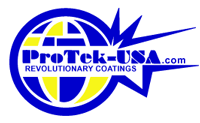 |
Tel (206) 782-8399 Toll-Free (800) 420-2998 Fax (206) 782-7532 sales@protek-usa.com |
|
|||||||||||
|
|
ENERGY RESOURCES: Articles Do You Know Your Roof’s True Colors?When the sun shines, roof temperatures range from comfortably warm to egg-frying hot. The temperature of a roof depends on how much sunlight it can reflect. Lawrence Berkeley National Laboratory tested different roofing materials when the ambient air temperature was 55 degrees F. Here are the peak temperatures found by the study:
Studies by Lawrence Berkeley National Laboratory (LBNL) and the Florida Solar Energy Center have found considerable variances in differing roofing materials, including single-ply membranes, built-up roof systems, metal roofing and modified bitumen, the types most commonly found on commercial and institutional buildings. Many single-ply membranes are available in white with reflectances of 70 to 80 percent or more. For some single plies, including EPDM, a dark membrane can be combined with a white coating to achieve the same reflectance, provided the coating is properly applied. Built-up roofing systems (BUR) vary widely, from 5 to 80 percent, depending on the surfacing. For BURs surfaced with aggregate, LBNL reflectance data ranges from 10 percent for dark aggregate to nearly 50 percent for white marble chips. Covering dark aggregate with a white cementitious coating can increase reflectance to 55 or 60 percent. Using a white reflective coating on a built-up roof can yield higher reflectances of 70 to 80 percent. Metal roof products are available with white coatings, which raise solar reflectances to about 65 percent. In addition, other metal roof products are available without a coating that meet the Energy Star specifications. According to Florida Solar Energy Center and LBNL studies, modified bitumen’s reflectance ranges from 5 to 25 percent, but it is possible to increase reflectivity to about 65 percent by adding a white reflective coating. Concrete and clay tile may be purchased in white, increasing solar reflectance to about 70 percent, as compared to 20 to 30 percent for red tile. Building Operating Management |
| Copyright ©
2003. All rights reserved. |
Contact webmaster with problems or questions about this site | Last Updated: 04/11/2003 |